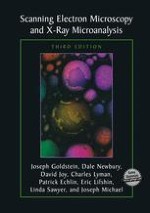2003 | OriginalPaper | Chapter
Procedures for Elimination of Charging in Nonconducting Specimens
Authors : Joseph I. Goldstein, Dale E. Newbury, Patrick Echlin, David C. Joy, Charles E. Lyman, Eric Lifshin, Linda Sawyer, Joseph R. Michael
Published in: Scanning Electron Microscopy and X-ray Microanalysis
Publisher: Springer US
Included in: Professional Book Archive
Activate our intelligent search to find suitable subject content or patents.
Select sections of text to find matching patents with Artificial Intelligence. powered by
Select sections of text to find additional relevant content using AI-assisted search. powered by
The specimen can be thought of as an electrical junction into which flows the beam current iB. The phenomena of backscattering of the beam electrons and secondary electron emission represent currents flowing out of the junction, iBSE and iSE, respectively. For a copper target with an incident beam energy of 20 keV, η is approximately 0.3 and δ is approximately 0.1, which accounts for 0.4, or 40%, of the beam current. The remaining beam current must flow from the specimen to ground to avoid the accumulation of charge in the junction (Thevenin’s current theorem). The balance of the currents is then given by 15.1$$ \eqalign{ & \sum {{i_{in}}} = \sum {{i_{out}}} \cr & {\rm{ }}{i_B} = {i_{BSE}} + {i_{SE}} + {i_{SC}}, \cr} $$ where iSC is the specimen (or absorbed) current. For the example of copper, iSC = 0.6iB. Thus, even with a conducting specimen such as a metal, an electrical connection must be established to conduct this substantial current from the specimen to ground (typically the specimen stage is wellgrounded). Because all materials (except superconductors) have the property of electrical resistivity ρ, the specimen has a resistance R ( R = ρl / A, where l is the length of the specimen and A is the cross section). The passage of the specimen current iSC through this resistance will cause a potential drop across the specimen, V = iSCR. For a metal, ρ is typically of the order of 10-6 ohm-cm, so that a specimen 1 cm thick with a crosssectional area of 1 cm2 will have a resistance of 10-6 ohm, and a beam current of 1 nA (10-9 A) will cause a negligible potential of about 10-15 V to develop across the specimen.
